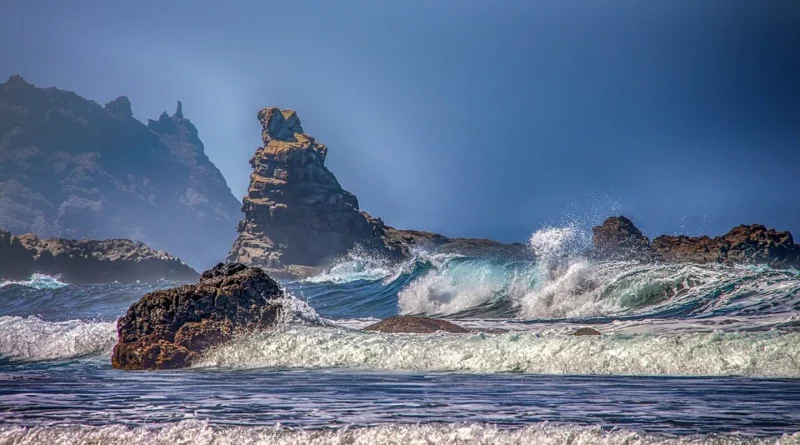What Is the Ocean?
Basically, the ocean is a large body of water, consisting of salt water. It covers about 70 percent of the surface of the Earth. It is the largest body of water, with a volume of about ninety-seven percent of all the water on Earth. The seas, or oceans, are not all the same, and some oceans are warmer than others. The oceans are classified according to their temperature and depth.
What is ocean explain?
Table of Contents
Depending on your perspective, the ocean is a massive body of water. It is also a rich source of life, particularly in the form of microorganisms and biomedical organisms. In fact, the largest concentration of life on Earth is in the ocean.
The ocean is a marvel of engineering and has been the envy of scientists for centuries. The best part is that you can now view it as a living entity thanks to technology. If you’re lucky enough to get out to the ocean, you may even have a glimpse of a plethora of critters scurrying about in the deep blue yonder.
The ocean is also home to the largest sea floor volcanoes on the planet. This may not be a bad thing, considering that it has been the site of a number of large explosions. The ocean is also the host to a number of bizarre creatures. These include sea scorpions, squid, and sea snakes, to name a few. The ocean also provides a large volume of oxygen to breathe.
How are oceans classified?
Generally, oceans are divided into four zones. Those zones are the abyssopelagic, epipelagic, mesopelagic, and bathypelagic zones. These zones are categorized according to their depth and the characteristics of the water.
The abyssopelagic zone is a layer of the ocean that extends from about 13,000 to 14,000 feet below the surface. Despite its depth, the marine environment still contains many life forms. Some of the creatures found in the abyssopelagic layer are sea spiders and isopods. The other creatures found in this layer are mollusks, sea cucumbers, and jellyfish.
The mesopelagic zone is a middle layer of the ocean that extends from the bottom of the epipelagic zone to the point where the sunlight cannot reach. In this region, the pressure is extremely high. Many of the marine animals found in the mesopelagic zone are large fish.
The epipelagic zone is a part of the upper open ocean, extending from the surface to about 200 meters below the surface. This zone is populated by many animals that are iconic to the ocean. These animals include plankton, which is a mixture of microscopic organisms.
What are the 7 oceans called?
Throughout history, oceans have been called by different names. Some have been based on geographic and scientific reasons. Other names have been given for navigational reasons. Some of these names have been popular. Several poems and songs have been written about sailing the seven seas.
The Atlantic Ocean is the second largest ocean on earth. It covers one-fifth of the surface of Earth. The Southern Ocean is the fourth largest. It is geologically the youngest of the five oceans. It is also the only ocean that completely surrounds one continent.
The Atlantic Ocean and the Southern Ocean are joined by parts of the Indian Ocean. The Atlantic Ocean is divided into North and South Atlantic Oceans.
The Mediterranean Sea is also part of the Atlantic Ocean. This ocean is located between Africa and Australia. Some of its smaller parts are the East Siberian Sea, the Barents Sea, and the Chukchi Sea.
In the 19th century, the Atlantic Ocean and the Pacific Ocean were divided into north and south subdivisions. In modern times, the Atlantic Ocean is still considered to include the Mediterranean Sea.
What are the 5 oceans called?
Throughout history, the term “ocean” has been used to refer to several water bodies. Depending on the location, the term can also be used to refer to different types of water.
The largest of the five oceans is the Pacific. This ocean extends from the west coast of North America to Australia, eastward to Asia, and then northward to the Arctic Ocean. The Atlantic is the second largest of the five oceans. Its area is approximately 106,400,000 square kilometers, and it is surrounded by Africa, Europe, and the Americas.
The third largest of the five oceans is the Indian Ocean. It covers a large portion of the Middle East and Africa. It is also connected to the Atlantic, Pacific, and Southern oceans. It is the longest ocean in the world.
The fourth largest of the five oceans is the Arctic. It covers approximately 5 million square miles and is the coldest of the five oceans. It is linked to the Atlantic Ocean by the Arctic Ocean. It is also linked to the Indian Ocean by the Mid-Atlantic Ridge.
What are the 7 seas and 5 ocean?
Historically, the term “Seven Seas” has been used to refer to a number of different bodies of water. It has also been used to describe certain regions of the world and various trade routes.
The phrase is believed to have originated in the ancient Sumer civilization in 2300 BC. The word “sea” translates to “water”. During the age of discovery, the term was used to describe the waterways between Arabia and China.
The phrase “Seven Seas” is often used to refer to the five major oceans of the world. These include the Atlantic, Indian, Pacific, and Arctic oceans.
The Atlantic Ocean is divided into North and South Atlantic. The Mediterranean and the Caribbean Sea are also part of the Atlantic Ocean. It also contains the Gulf of Mexico and the Persian Gulf.
The Pacific Ocean, on the other hand, extends from the equator to Antarctica. It touches Australia, west coast of the United States and east Asia.
The Arctic Ocean is one of the most delicate ecosystems on the planet. It is located between the North Pole and North Eurasian continent. It is covered with ice and contains a wide variety of fish species. It also has a sparse plant life.
What is the deepest sea on Earth?
Located in the western Pacific Ocean, the Mariana Trench is the deepest oceanic trench on Earth. It stretches over 2,550 kilometers and is about 43 miles wide. It is also home to Challenger Deep, the deepest known point on Earth.
Challenger Deep is located at the southern end of the Mariana Trench, a crescent-shaped depression. It measures nearly seven miles deep and has conditions of absolute darkness.
The other deepest sea in the world is the Java/Sunda/Java-Sunda Trench, a 2,000-mile chasm off the coast of Sumatra. It is also the deepest in the Southern Hemisphere.
The Atacama Trench is another deep oceanic depression located in the western Pacific Ocean. It reaches a maximum depth of 8.06 km below sea level. It is also home to many interesting species.
The Bering Sea is the third deepest sea on Earth. It measures 4773 meters deep and has the highest salinity of any sea on Earth.
The South China Sea is the second deepest sea on Earth, with a maximum depth of 16,456 meters.
What is the deepest ocean?
Located in the western part of the Pacific Ocean, the Mariana Trench is the deepest place on Earth. Its name comes from nearby Mariana Islands. This region is so deep that it is actually part of the oceanic trench network. Its deepest point is 35,813 feet below the surface.
It is a deep-water trough formed by the collision of two converging tectonic plates. It is also called the Ring of Fire. It runs along the United States west coast, and it passes through Indonesia, the Philippines, and New Zealand.
The first person to explore the depths of the Mariana Trench was US Navy lieutenant Joe Walsh. He made the first dive into the trench on January 23, 1960. He reported seeing large flatfish. He claimed to have seen an oceanic “snailfish” too, but scientists are not convinced.
The second deepest ocean is the Atlantic Ocean. The average depth of the Atlantic Ocean is 3.6 km. The Atlantic Ocean is more dangerous than the Pacific Ocean because it is subjected to rapid temperature changes. The Atlantic Ocean is also more susceptible to coastal winds.
What is the warmest ocean?
Currently, the warmest ocean is the Indian Ocean. This ocean is located in the tropics and it is bordered by Asia, Africa and Australia. It is also the third largest ocean on the planet.
The Indian Ocean is home to a wide variety of plants and animals. These animals include sea giant turtles, sharks, tuna and other types of fish. It also has a huge population of plankton. This plankton is the food source for large fish.
The Indian Ocean has a long-term record of rapidly warming, which is caused by the human-induced greenhouse effect. Since the mid-20th century, the Indian Ocean has been warming more rapidly than other tropical regions. This is the cause of the overall warming of ocean surface temperatures.
Unlike the other oceans, the Indian Ocean stays warm all year long. Its temperature ranges from 19 to 30 degrees Celsius. It also has high salinity because of the insufficient desalination of seawater.
Another reason that the Indian Ocean is the warmest is because of its abundance of plankton. Plankton are essential to the survival of many types of marine animals. They are a food source for large fish, such as marlin and whale sharks.
Oceans in the Pacific, Atlantic, Indian, Arctic, and Antarctic Oceans
Approximately 72% of the earth’s surface is covered by one of the five oceans. These five oceans range in size and have varying environmental characteristics. Each ocean has its own ecosystem, and they are also distinct from one another.
The Pacific Ocean is the largest ocean on earth. It covers more than a third of the world’s surface, and is a relatively peaceful ocean. It is bounded on the north by the Arctic Ocean and on the south by the Antarctic Ocean.
The Atlantic Ocean is the second largest ocean, and is bounded on the west by the continents of Africa and Europe, on the east by the Americas, and on the north by the equator. It is the most heavily traveled ocean. It contains several aquatic species and has the Drake Passage, which is a 600-mile passage between the Antarctic Peninsula and the South American continent.
The Indian Ocean is bounded on the east by Australia, on the south by Africa, and on the west by Europe. It occupies about 20 percent of the world’s sea surface. The waters are suitable for plant life, but are generally warm.
The Arctic Ocean is the smallest of the five oceans. It is nearly circular, and touches North America in the Western Hemisphere. It has a delicate ecosystem and a large amount of undiscovered petroleum resources.
The Atlantic Ocean has a shoreline of more than 52 million square miles. It is divided into two nominal sections: the North Atlantic, which is bounded on the north by the North Sea, the Gulf of Mexico, and the Atlantic Ocean, and the South Atlantic, which is bounded on the south by the Cape Agulhas, the North Atlantic, the Atlantic Ocean, and the Indian Ocean.
The Southern Ocean is the fourth largest ocean, and it surrounds the Atlantic Ocean to the south. It extends from the coast of Antarctica to 60 degrees south latitude. It is the youngest of the five oceans. It contains an abundance of krill, which are a food source for the sperm whale, the largest living toothed animal.
Oceans in the Arctic
During the past 30 years, a team of researchers from the Arctic Summer Cloud Ocean Study has been using icebreakers and passing ships to measure surface turbulent fluxes and water signatures in the Arctic Ocean. Their results show strong correlations between surface turbulent fluxes and sea ice cover. This has important implications for the climatic and environmental implications of sea ice melt in the Arctic.
The atmospheric circulation in the Arctic Ocean is organized into synoptic and low-frequency features. These features are influenced by ocean and atmospheric variables. For example, the movement of warm and cold air masses has significant local effects on surface temperatures and heat storage.
Sea ice has an impact on ocean surface reflectivity and humidity. For example, when sea ice melts, it promotes water freshening. It also limits wind-induced turbulent mixing in the ocean. However, it is not clear whether wave activity has an effect on surface turbulent fluxes.
Sea ice and phytoplankton blooms are important indicators of primary productivity in the Arctic Ocean. Satellite-based measurements of chlorophyll are used to measure phytoplankton growth. However, satellite-observed chlorophyll is an imperfect measure, as it does not include phytoplankton blooms under the sea ice. These blooms may play a role in the food web in the Arctic.
Satellite-retrieved surface turbulent fluxes in the Arctic Ocean exhibit strong seasonal variations. The eastern Arctic region exhibits positive LH fluxes year-round, while the western Arctic region has LH fluxes only in the summer. In the eastern Arctic, the largest increase in LH fluxes occurs in the Kara Sea during the summer. This increases the water vapor flux by up to two percent.
In addition, sea ice has a significant impact on the ocean mixed-layer depth. This depth varies seasonally, due to the seasonal change in sea ice cover and the atmospheric circulation. The depth of the mixed-layer may limit the surface turbulent fluxes and influence stratification. The deepest part of the mixed-layer occurs during ice-free periods. This deepening may also limit the air-sea temperature gradient.
Several authors have studied the vertical structure of the chlorophyll profile in the Arctic Ocean. They have found that there is a significant difference in chlorophyll concentrations between regions with sea ice and those without. This has implications for estimates of areal primary production.
Oceans in the Southern Ocean
Despite its comparatively small area, the Southern Ocean has a complex biogeochemistry. It is not only a cold water mass that encircles Antarctica, but it also links the world’s major ocean basins. This complex environment is a subject of interest to scientists and the general public alike.
In particular, the marine carbon cycle is one area where a lot is going on. For example, eddies are important in the equatorial transport of carbon. Researchers are now proposing to investigate this aspect of the carbon cycle more closely.
In addition to being an important part of the carbon cycle, the ocean plays a role in global climate. A few examples include the rapid retreat of summer sea ice cover and the increasing westerlies. These changes may have significant impacts on the polar ocean’s CO2 uptake. However, not all ocean water is created equal. Some water is cold, some is warm, and some is saltier. It’s all part of a global feat of movement.
The marine carbon cycle is just one aspect of the Southern Ocean’s complex biogeochemistry. A better understanding of its response could help scientists evaluate a wide range of changes.
The ocean’s biogeochemical response to atmospheric forcing may be more robust than previous studies suggest. It has been suggested that enhanced stratification in the deep Southern Ocean may play a role in reducing atmospheric CO 2 concentration. It also has the potential to alter the marine carbon cycle. The ocean’s biogeochemical response has been modeled in a numerical model. Among other features, the model includes atmospheric chemistry, ocean sea ice, oxygen, and alkalinity.
A few examples of the Southern Ocean’s biogeochemical response include the Antarctic Circumpolar Current (ACC). The ACC is a large-scale circulation that encircles Antarctica without wrapping back to the west. This circulation is also responsible for connecting the low and high southern latitudes. The ACC is also associated with the Southern Ocean’s mid-ocean ridges. It has also been suggested that increased westerlies may have consequences for the polar ocean’s CO2 uptake.
While the ocean’s biogeochemical response to increased CO 2 is robust, it may be counterbalanced by northward eddy transport.
Oceans in the Indian Ocean
Often referred to as the “Ocean of the South,” the Indian Ocean is located between Southeast Asia and Africa. It is the third largest ocean in the world. Its water volume is estimated at 292,131,000 cubic kilometers. It is bounded by Australia, Southeast Asia, and Africa.
The Indian Ocean has a diverse range of creatures. Its water temperature is 71 degrees Fahrenheit. The average depth of the ocean is 3872 meters. Water temperature varies by location.
The Indian Ocean is considered the warmest of all the world’s major oceans. However, due to its deep water, it has an increased frequency of severe cyclonic storms. These storms can intensify into 2.5 degree blocks of the BOB.
It is surrounded by several islands, including Indonesia, Sri Lanka, Madagascar, Comoros, Mauritius, and Seychelles. The region is also populated by a number of endangered marine species.
The Indian Ocean is a key trading hub. Throughout history, trade routes have connected East Africa to the Arab World and Southeast Asia. After World War II, the region was decolonized and independent countries began focusing on immediate security issues. The region’s geopolitics revolve around military presence near key choke points, or Sea Lines of Communications protection.
The ocean’s strategic significance has caused conflict. The oceans in the Indian Ocean are home to a number of species, but fishing is limited to subsistence levels. Maritime traffic can be severely disrupted at key choke points. The Suez Canal, for example, is the subject of a dispute between developing nations and the United Kingdom. It is also the site of a major oil transportation network. The United States has been a major player in the region during the Cold War. After the war, however, it decreased its involvement.
A 2004 Indian Ocean earthquake caused a tsunami that caused more than 226,000 deaths and caused over one million homeless. The tsunami was triggered by a rupture in an underwater earthquake. The ocean is also a major source of plastic waste.
In fact, the ocean is the world’s second-largest polluted ocean. About 99% of ocean litter is plastic. It is estimated that over a trillion pieces of plastic waste are floating in the ocean.




